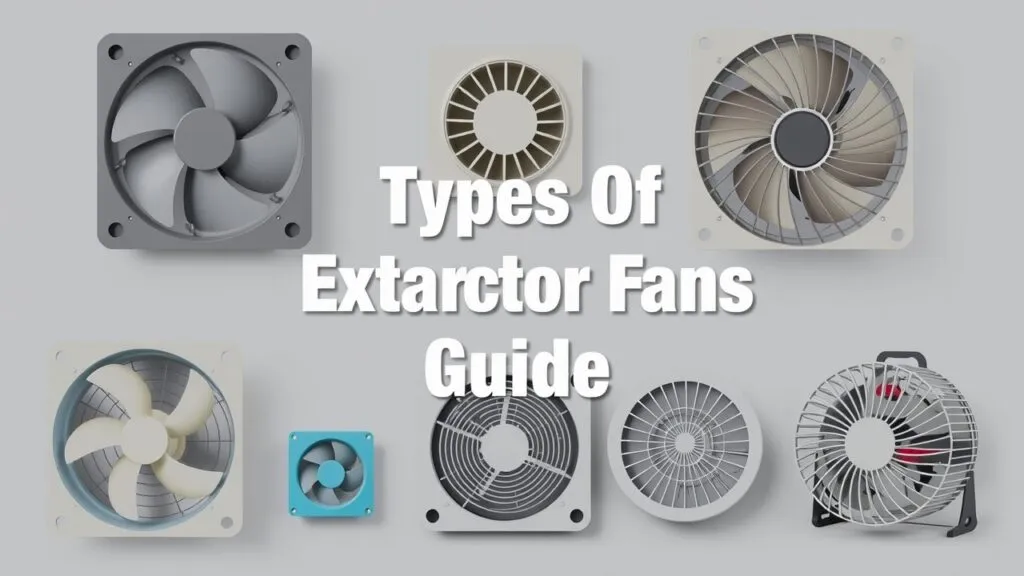Types of extractor fans include bathroom exhaust fans, range hoods, and general-purpose models. This guide helps you choose the best fan based on size, CFM, and room type.
What is an extractor fan?

An extractor fan, also called a ventilation fan or exhaust fan, helps remove stale air, moisture, and odors from indoor areas. These fans are important for keeping good air quality in homes and businesses. There are different types of extractor fans available today, like axial fans, centrifugal fans, and inline extractor fans. Each one has a unique design suited for specific uses.
Axial fans push air parallel to the blades and work well in smaller spaces like bathrooms or kitchens where you need direct airflow. Centrifugal fans pull air into the center before pushing it out at a right angle. They’re often used in bigger systems needing stronger airflow. Inline extractor fans fit into ductwork, making them useful for effective ventilation over longer distances without taking up room space.
Why are extractor fans essential for indoor spaces?
Extractor fans are key for better indoor air quality. They help get rid of extra moisture that can cause mold and mildew. In places like kitchens and bathrooms where humidity levels rise quickly from cooking or bathing, these ventilation systems keep conditions just right.
Also, good ventilation removes bad smells from cooking or household products. By promoting fresh air circulation throughout your home or business, you can save energy too—reducing how much you depend on heating or cooling while making living spaces healthier.
Common applications of extractor fans
Extractor fans are used in many places:
- Bathrooms: Bathroom exhaust fans lower humidity after showers.
- Kitchens: Kitchen range hoods pull out smoke while filtering grease.
- Workshops: Industrial exhaust fans clear fumes from tools and machines.
- Commercial Spaces: Utility room vents manage temperature and remove moisture.
When choosing an extractor fan, consider the size based on the room and the best installation methods for each setting’s needs.
Benefits of proper ventilation
Having good extraction systems offers several benefits:
- Mold Prevention: It helps control condensation in areas like basements where dampness can build up.
- Odor Removal: Getting rid of lingering smells from cooking makes indoor spaces more pleasant.
- Improved Air Quality: Circulating clean outdoor air reduces allergens indoors—making life better for everyone there.
Understanding what an extractor fan does—and its importance across various settings—helps homeowners and small business owners make smart choices about improving their indoor environments with effective ventilation solutions that meet their needs!
Types of Extractor Fans Explained
Axial Fans: Best for Small Spaces and Simple Ventilation Needs
Axial fans are great for tight areas like bathrooms and kitchens. They move air parallel to the fan’s axis. This makes them perfect for basic ventilation needs. These fans usually have low-CFM options, which means they can remove moisture and odors without using much energy.
When picking an axial fan, think about the size and how noisy it is. Many affordable extractor fans work quietly, which is important in homes where peace matters. For example, bathroom exhaust fans often use axial designs because they are compact and effective at keeping air fresh.
Key Features of Axial Fans:
- Compact Size: Fits well in small spaces.
- Low Noise Levels: Operates quietly for home use.
- Energy Efficient: Uses less power while moving air effectively.
Centrifugal Fans: High Airflow for Larger or Complex Spaces
Centrifugal fans are built for places that need a lot of airflow. They work well in bigger areas or complex ventilation systems. These fans move air at a right angle to the intake direction with a rotating impeller. This design helps them create higher pressure than axial fans.
These powerful exhaust fans are often found in industrial settings. They can also help in large kitchens or bathrooms where moisture needs to be removed quickly. When selecting a centrifugal fan, check its CFM rating. High-CFM models work well even under tough conditions and save energy too.
Benefits of Centrifugal Fans:
- High Airflow Capacity: Ideal for larger areas.
- Versatile Applications: Works well in different environments.
- Energy Efficiency Options Available: Helps lower running costs over time.
Inline Extractor Fans: Quiet Operation Within Ductwork Systems
Inline extractor fans are special because they go inside duct systems instead of being mounted on walls or ceilings. This design allows them to run quietly since the motor stays away from living spaces. Inline models are great when space is limited or when looks matter more than visible fans.
These compact options effectively ventilate entire rooms through ducted systems without causing noise—perfect if you want to keep things peaceful indoors while ensuring good air flow.
Advantages of Inline Extractor Fans:
- Quiet Performance: Less noise during operation.
- Space-Saving Design: Fits nicely into existing ducts.
- Effective Air Movement Across Distances: Keeps airflow steady throughout your area.
Whole-House Ventilation Systems for Continuous Air Quality Improvement
Whole-house ventilation systems are advanced solutions for indoor air quality. They constantly circulate fresh outdoor air throughout your home or business. These systems include Heat Recovery Ventilators (HRVs) and Energy Recovery Ventilators (ERVs). They enhance comfort while being energy efficient.
Running all the time—often with continuous running fans—these units help control humidity levels and filter out pollutants better than simply opening windows or using standalone extractors occasionally.
Key Features of Whole-House Systems:
- Continuous Operation Improves Indoor Air Quality
- HRV Units Recover Heat from Exhausted Air
- ERV Units Balance Humidity Levels
Choosing the right extractor fan type depends on your space size, noise level preferences, and specific needs—all key factors when planning any ventilation upgrades!
Extractor Fan Comparison
| Feature | Axial Fan | Centrifugal Fan | Inline Fan | Whole-House System |
|---|---|---|---|---|
| Airflow Capacity (CFM) | Low | High | Medium | High |
| Noise Level | Moderate | Low | Very Low | Varies |
| Installation Complexity | Easy | Moderate | Moderate | Complex |
| Cost | Affordable | Higher | Medium | Expensive |
| Space Requirements | Small | Moderate | Compact, duct-friendly options | Varies |
Axial Fans: Best for Small Spaces and Simple Ventilation Needs
Axial fans work by spinning blades around a central axis. This creates airflow in the same direction as the fan’s shaft. You’ll often find these fans in bathrooms and small kitchens where the need for ventilation is low. Their small size makes them a budget-friendly choice for folks looking to improve air circulation.
These fans are easy to install and cost-effective, but they don’t move as much air compared to other types. This means they might not work well in bigger spaces or places with a lot of humidity.
Centrifugal Fans: High Airflow for Larger or Complex Spaces
Centrifugal fans have a spinning impeller that pulls air into the center and pushes it out at a right angle through ducts. This design helps them move a lot of air, making them perfect for large kitchens or industrial areas where ventilation is important.
Even though these fans are powerful, their installation can be trickier than axial models. You might need professional help, which can also add to the costs. But if you need high airflow capacity, centrifugal fans are worth considering.
Inline Extractor Fans: Quiet Operation Within Ductwork Systems
Inline extractor fans fit into ducted systems, often located in attics or crawlspaces. They work quietly because they push air through ducts rather than directly from the room. This makes them great when noise is a concern.
However, putting in inline extractor fans can be tough due to space limits and specific needs related to duct layout.
Whole-House Ventilation Systems for Continuous Air Quality Improvement
Whole-house ventilation systems include energy recovery ventilators (ERV) and heat recovery ventilators (HRV). They run all the time to keep fresh air flowing throughout your home while filtering out pollutants. These systems help exchange stale indoor air with fresh outdoor air efficiently.
They’re ideal for homes that need consistent ventilation without sacrificing comfort. However, these systems usually require more complicated installation compared to single extractor fan types due to their complexity and cost implications.
Choosing the Right Extractor Fan: Key Considerations
CFM Calculation
When picking an extractor fan, knowing about CFM (Cubic Feet per Minute) is key. CFM shows how much air a fan can move in a minute. To figure out the right CFM for your room, you must calculate the room’s volume and decide how many air changes per hour (ACH) you want.
Formula:
CFM = Room Volume (cubic feet) × Desired ACH / 60
For kitchens, you usually need more airflow because of cooking smells and steam. Aim for 15-20 ACH in kitchens. For bathrooms, 8-10 ACH is usually enough.
Example Calculation:
If your kitchen measures 200 cubic feet and you want 15 ACH:
CFM = Room Volume (cubic feet) × Desired ACH / 60 = 50
So, look for an extractor fan with at least a 50 CFM rating.
Room Size and Airflow Requirements
It’s super important to match your extractor fan’s capacity with your room size. This helps ensure good airflow without too much or too little power.
Here are some tips:
- Kitchens: Choose high-CFM exhaust fans since they deal with more moisture from cooking.
- Bathrooms: A powerful yet quieter model works well here, as bathrooms usually don’t need as much airflow but still benefit from effective moisture removal.
To choose the right size:
1. Measure your rooms.
2. Calculate needed CFM based on size.
3. Pick models that meet those needs while also keeping noise levels in mind.
Noise Level Considerations
Noise level is another big deal when choosing an extractor fan. Fans have ratings in sones or dB(A). Lower numbers mean quieter operation—great for homes where you want peace.
For instance:
– Quiet bathroom fans usually run at less than 1 sone (<30 dB).
– Kitchen fans can range from 3 to 5 sones based on their power.
Think about what you prefer; some people really want a quiet fan, especially if their kitchen or bathroom is close to living spaces.
Budget and Installation
Money plays a big part in deciding which extractor fan to buy. Prices vary based on features like energy efficiency or smart home tech, like built-in timers.
Installation costs also change based on complexity. Some simple models just need basic tools, while others may require a pro for electrical work or ducting. Always keep potential installation costs in mind when planning your ventilation setup.
Special Features
Today’s extractor fans come with cool features that do more than just move air:
- Smart Home Integration: Some fans link to home systems so you can control them from your phone.
- Timers & Motion Sensors: These features let the fan turn on/off automatically based on whether someone is around.
- Energy Efficiency Options: Look for ENERGY STAR-rated fans; they save money over time by using less electricity while still providing good ventilation.
These features make life easier and help save energy by adjusting how they work depending on conditions inside each room.
Installation, Maintenance, and Troubleshooting
General installation tips
When you install an exhaust fan, follow some easy guidelines. Start by picking the right spot for your fan. It should be close to areas that get wet, like showers or stoves. If you’re into DIY projects, gather all your tools before you begin.
If you want a pro to do it, hire a qualified electrician. They know local building codes and safety rules. Always turn off the power at the circuit breaker before doing any electrical work. Also, think about adding a backdraft shutter. This helps stop outside air from coming in when the fan is off.
Regular cleaning and filter replacement schedules
Keeping your exhaust fan clean is key for it to work well. Regular cleaning gets rid of dust and grease that can block airflow. If you use your fan a lot, clean it every few months.
Don’t forget about the filters! If your fan uses baffle filters or charcoal filters, check them often. Baffle filters need washing every 3-6 months. Charcoal filters may need changing more often based on how much you use them.
Troubleshooting common issues
Exhaust fans can have some typical problems:
- Backdrafting: This happens when outside air sneaks back into your home instead of being pushed outside. A backdraft shutter can help fix this.
- Condensation: Too much moisture can cause condensation in ducts if not handled right. A condensation trap might be needed to catch extra water and stop damage.
- Noise: The noise level can differ among types of exhaust fans (like axial vs centrifugal). If the noise bothers you, check the decibel rating of your fan; quieter models are out there if you need one.
Optimizing Your Home’s Ventilation
Understanding the types of extractor fans is key for improving your home’s ventilation. Each type meets different needs. This helps keep indoor air fresh and energy use low. Extractor fans can be classified into a few main types: axial fans, centrifugal fans, and inline extractor fans.
Importance of Selecting the Right Fan
When you pick an extractor fan, think about room size and airflow needs, which are often measured in cubic feet per minute (CFM). Here are some things to consider:
- Axial Fans work well in smaller rooms like bathrooms since they can push air directly through a duct.
- Centrifugal Fans are better for larger spaces or areas that need more pressure, making them great for kitchens or commercial places.
- Inline Extractor Fans allow flexible installation and usually run quietly.
You should also check noise levels in decibels (dB(A)). Quieter models are usually better for homes. Features like humidity sensors or timers can improve how the fan works by adjusting to the environment.
Recommendation for Professional Consultation
For tricky installations, like whole-house ventilation systems with many ducts, it’s smart to talk to a professional. They know local building codes and can design systems that work well together. Pros can evaluate your space properly and suggest options that fit your specific needs.
FAQs about Extractor Fans
What features should I look for in the best extractor fans?
Look for energy-efficient models with features like timers and humidity sensors. Smart home integration can enhance control. Also, consider noise levels. Quieter fans work well in residential areas.
How do I choose the right size extractor fan for my bathroom?
Measure your bathroom’s square footage. For a small bathroom, aim for at least 50 CFM. Medium bathrooms need around 70-100 CFM. Larger bathrooms require over 100 CFM for effective ventilation.
What are the differences between ducted and ductless extractor systems?
Ducted systems move air outside through ducts, ensuring effective moisture removal. Ductless systems filter air and recirculate it indoors, ideal for spaces without ductwork.
How can I ensure quiet operation from my extractor fan?
Choose low-noise extractor fans with a sone rating below 1.5 for quieter operation. Inline fans also help reduce noise since they are placed away from living areas.
How often should I clean my extractor fan filters?
Clean your filters every 3 to 6 months, depending on usage. Replace charcoal filters more frequently to maintain optimal performance and air quality.
Additional Keywords
Ventilation Solutions
- Ducted systems provide efficient moisture removal.
- Ductless options work well where ducts aren’t feasible.
- Whole-house systems ensure constant airflow.
Fan Installation
- DIY installation can save costs.
- Hiring professionals ensures safety and code compliance.
Fan Maintenance
- Regular cleaning enhances performance.
- Check electrical components periodically.
Energy Saving
- ENERGY STAR-rated fans consume less power.
- Smart features can reduce unnecessary usage.
Noise Reduction
- Choose fans with low decibel ratings.
- Look for models with built-in soundproofing features.
Smart Features
- Models with app control offer convenience.
- Integration with Alexa or Google Assistant enhances usability.
Exhaust Fan Brands
- Research brands known for reliability and performance.
- Read customer reviews to compare options effectively.
These points cover additional aspects of extractor fans while maintaining clarity and focus on your main keyword.
Related Topics
- Types of ventilation systems
- Types of fan filters
- Types of whole-house ventilation systems
- Types of bathroom exhaust fans
- Types of kitchen exhaust fans
- Types of ductwork for extractor fans



Types of Extractor Fans: A Complete Guide